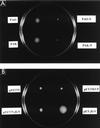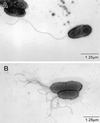fleN, a gene that regulates flagellar number in Pseudomonas aeruginosa
- PMID: 10629180
- PMCID: PMC94283
- DOI: 10.1128/JB.182.2.357-364.2000
fleN, a gene that regulates flagellar number in Pseudomonas aeruginosa
Abstract
The single polar flagellum of Pseudomonas aeruginosa plays an important role in the pathogenesis of infection by this organism. However, regulation of the assembly of this organelle has not been delineated. In analyzing the sequence available at the Pseudomonas genome database, an open reading frame (ORF), flanked by flagellar genes flhF and fliA, that coded for a protein (280 amino acids) with an ATP-binding motif at its N terminus was found. The ORF was inactivated by inserting a gentamicin cassette in P. aeruginosa PAK and PAO1. The resulting mutants were nonmotile on motility agar plates, but under a light microscope they exhibited random movement and tumbling behavior. Electron microscopic studies of the wild-type and mutant strains revealed that the mutants were multiflagellate, with three to six polar flagella per bacterium as rather than one as in the wild type, indicating that this ORF was involved in regulating the number of flagella and chemotactic motility in P. aeruginosa. The ORF was named fleN. An intact copy of fleN on a plasmid complemented the mutant by restoring motility and monoflagellate status. The beta-galactosidase activities of eight flagellar operon or gene promoters in the wild-type and fleN mutant strains revealed a direct correlation between six promoters that were upregulated in the fleN mutant (fliLMNOPQ, flgBCDE, fliEFG, fliDS orf126, fleSR, and fliC) and positive regulation by FleQ, an NtrC-like transcriptional regulator for flagellar genes. Based on these results, we propose a model where FleN influences FleQ activity (directly or indirectly) in regulating flagellar number in P. aeruginosa.
Figures





References
Publication types
MeSH terms
Substances
Grants and funding
LinkOut - more resources
Full Text Sources
Other Literature Sources
Molecular Biology Databases

